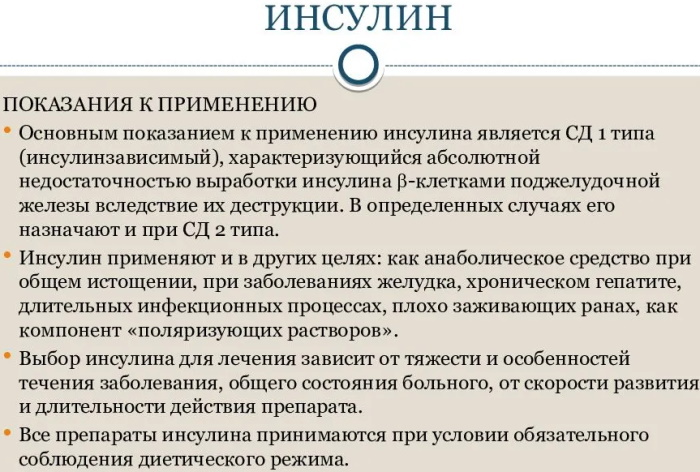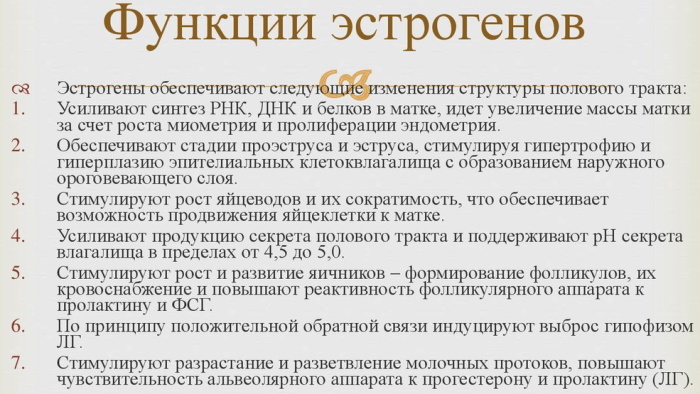Content
- What is clear diction and articulation for?
- Features of correct pronunciation in adults and children
- Secrets of Articulator Training for Articulating Sounds Clearly
- The best techniques and exercises to develop diction and articulation
- Articulation of sounds "Sh - Zh"
- Articulation of sounds "K - G, X"
- Working out the sound "C"
- Accelerated pronunciation
- Articulation gymnastics
- Cheek gymnastics
- Lower jaw gymnastics
- Gymnastics of the soft palate
- Lip gymnastics
- Gymnastics of the tongue
- Complexes and exercises for speech clarity
- For public speaking
- For vocals
- For staging speech in children
- Diction Exercise Videos
Exercises to develop diction and articulations are very popular, since they help not only in communicating with people, but are also necessary in professional activities. It will take a little time and patience to master these skills.
What is clear diction and articulation for?
Clear diction and articulation helps to quickly build relationships with people, allows you to get to know the opposite sex. It is often said about such people: "his tongue is hanging." However, in addition to everyday features, people with good diction can expect to work in any team where such skills are needed - television, cinema, translators.
What is diction for:
- To understand a person by the people around him. Despite the complex topic, a person with good diction can easily and quickly explain any topic.
- Make an impression. With conversational skills, you can easily gain the trust of anyone and make a good impression on them. This will help in negotiations and when concluding any contracts.
- Grab the attention of your audience. Such a person will always be listened to and understood. Skills are irreplaceable for teachers or those who work with large audiences.
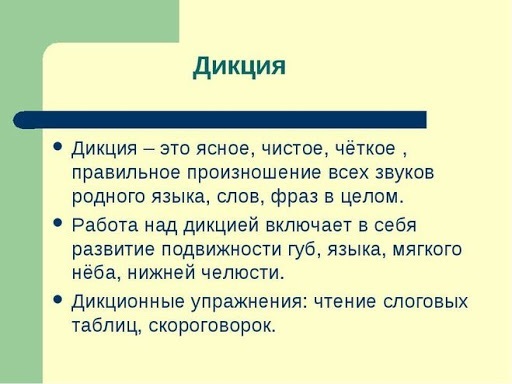
It is believed that any actor who does not have the proper training in terms of diction is bound to face difficulties on stage.
Features of correct pronunciation in adults and children
Exercises for diction and articulation can be performed independently at home, since they do not require any cost and time.
Violations of correct diction in both adults and children can be caused by various factors. In most cases, with a normal articulatory apparatus, the problem is associated with poorly developed diction and is not pathological in nature.
In more rare cases, impaired diction can be caused by various anomalies or pathologies in the speech apparatus:
- defects in the structure of the lips;
- underdevelopment of the frenum of the tongue;
- malocclusion.
The speeches of such people are repulsive, the listeners cannot make out the words, and the understanding of the topic deteriorates.
The speaker may be in a hurry, skip words, swallow endings or the middle of words. Some people say their monologue very lazily, replacing the letters at the same time.
The absence of pauses or intonation of the lecturer leads to a misunderstanding of the topic, the lecture becomes uninteresting.
The problem can be greatly aggravated when the speaker uses professional means - a microphone, the Internet, or other professional equipment.
In some cases, the speaker's tempo and rhythm of speech is out of order. This is due to the lack of practice of the lecturer, problems with voice production or underdevelopment of the facial muscles that take part in diction.
A characteristic difference between the development of diction in adults and children is that the problem requires much more time and effort to solve it. At the same time, in some cases, you have to turn to psychological help, since sometimes the problem with speech impairment can be associated with a person's personal experiences.
Secrets of Articulator Training for Articulating Sounds Clearly
Well-developed diction allows the audience to pronounce words clearly and correctly perceive them. To improve its quality, it is necessary to work on articulators.
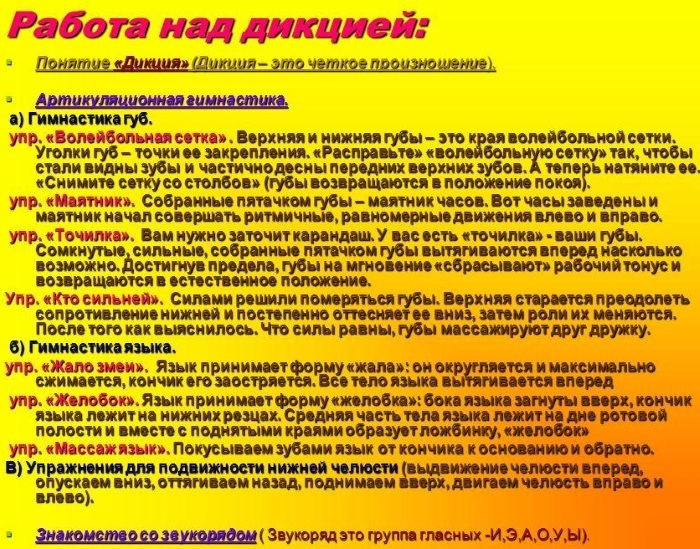
In the setting of correct articulation, 3 main sections are involved: tongue, lips and lower jaw. At the same time, the quality of articulation depends on the facial muscles located in the cheeks, larynx and the location of the upper palate.
To obtain clearer and more correct sounds, it is recommended to systematically perform special exercises. In this case, it is necessary to take into account the correct location of the lips, tongue, soft palate and lower jaw, taking into account each individual letter.
The best techniques and exercises to develop diction and articulation
Exercises for diction and articulation can be chosen independently or you can consult with a speech therapist who will help you choose the most suitable techniques.
You can improve pronunciation and the quality of diction with the help of special articulation complexes that make words and individual letters clearer.
Articulation of sounds "Sh - Zh"
To improve the pronunciation of the letter "Ш" it is necessary to round the lips and push them forward, creating a small gap between the teeth. The tip of the tongue and the front of its back should be slightly raised. In this case, it is necessary to ensure that they do not come into contact with the alveoli or incisors. The middle of the back of the tongue must be lowered, and the back must be raised.
The sides of the tongue should be pressed against the upper molars. The soft palate should be raised. Then they emit a mouth sound "Ш". After that, the vocal cords are opened and a dull sound "Ш" is pronounced.
To work out the sound "F", a similar exercise is performed. The only difference is that the speaker's vocal cords must be closed during pronunciation. In this case, the sound should be sonorous.
Articulation of sounds "K - G, X"
For the correct pronunciation of the sound "K" it is necessary to lower the tip of the tongue, move it away from the lower incisors deep inside the oral cavity. The back of the back of the tongue should be fixed in the form of a small hump. In this case, a bow should be formed between the hard and soft palates. The soft itself must be raised. The vocal cords should be opened. The sound "K" is dull.
The sound "G" is worked out in a similar way. However, unlike the previous sound, the position of the vocal folds should be closed.
The articulation of the "X" sound is identical to the elaboration of the "K" sound. However, there is a slight difference, which is that the back of the tongue should not form a bow. In its place there should be a small gap located at the junction of the soft and hard palate.
Working out the sound "C"
Exercise: The lips are in a neutral position. The gap between the jaws should be no more than 1-2 mm. In this case, the tip of the tongue should be positioned so that it rests against the lower incisors.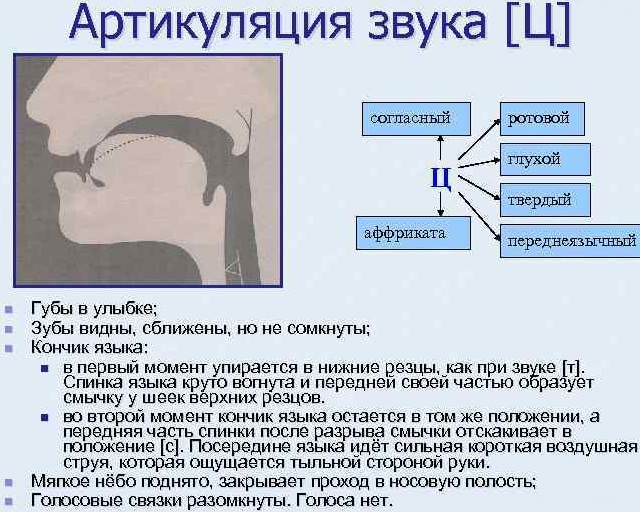
The front part of the back of the tongue should be slightly bent so that its lateral parts rest against the molars. After that, a kind of groove should turn out along the entire tongue.
During the pronunciation of the sound, the front part of the back of the tongue is necessary to the alveoli of the front teeth to form a bow. The same bridge should form between the back of the tongue and the alveoli of the upper teeth.
Accelerated pronunciation
Articulation exercises with acceleration are necessary for professional presenters, announcers, lecturers, orators. To speed up the tempo of speech and at the same time not to lose the clarity of the spoken words, you need to constantly train, increasing your pace. During the performance of the technique, you can use a voice recorder, which will allow you to better understand how much the quality of diction is reduced.
It is recommended to use tongue twisters as a warm-up. In most cases, speakers have problems with the pronunciation of sounds such as "Ж-Ш", "С-З" and the sound "R".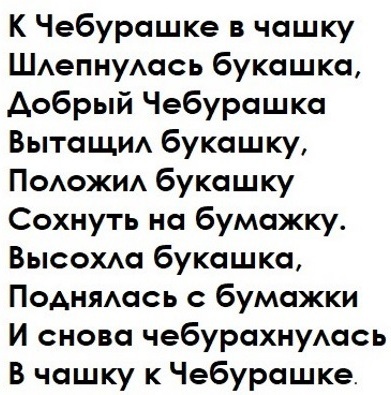
Examples of tongue twisters:
- The turtle turtle has turtle chobots on turtle paws.
- Yeast and reins went off-road. The yeast squealed, the reins trembled.
- Sonya and Sanya have catfish with a mustache in their nets. Catfish with a mustache in the nets of Sonya and Sanya.
- I rode a Greek across the river, sees a Greek - a cancer in the river. He put a Greek hand in the river, a cancer by the hand of a Greek - tsap!
- There is a goat with a scythe goat, there is a goat with a barefoot goat, there is a goat with a scythe goat, there is a goat with a barefoot goat.
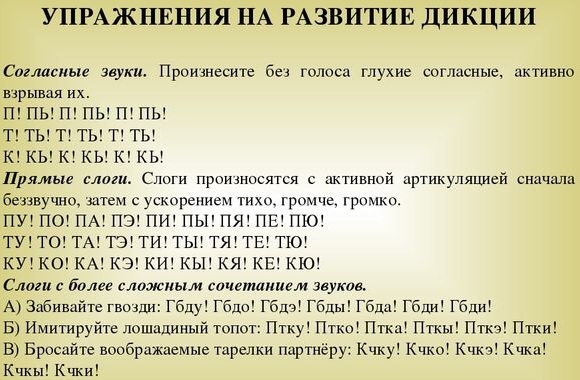
You can use other tongue twisters to help you prepare for the performance.
Articulation gymnastics
To improve the work of the articulation apparatus, it is necessary to perform various exercises. This or that method depends on the specific section of the speech apparatus that needs to be developed. However, it is best to work through all areas one at a time.
Cheek gymnastics
It is good for the cheeks to retract and inflate them one at a time. The exercise is performed several times for each cheek. Then they move on to the second exercise. Its essence is as follows: air is distilled from one cheek to another, after which it is driven first under the lower lip, then under the upper lip.
After that, they move on to the next technique: straining the cheeks and lips, as if trying to push the air out of the mouth at the same time. Then move on to the last exercise. To do this, both cheeks are pulled in, simultaneously closing and opening the lips. At the end of gymnastics, it is recommended to rest a little and move on to the next calving of the speech apparatus.
Lower jaw gymnastics
To work out the lower jaw, they rest against it with their fists and with little force press the jaw onto the fists. Do this several times. Then they perform various kneading actions: they move the jaw up and down, back and forth and make circular movements.
Gymnastics of the soft palate
You can knead and shape the soft palate using the following exercises:
- Yawning is performed with the mouth open.
- The tongue is collected in the form of a scapula and pulled up to the soft palate, after which it is returned to the alveoli.
- Pronounce all consonants in turn, while trying to yawn.

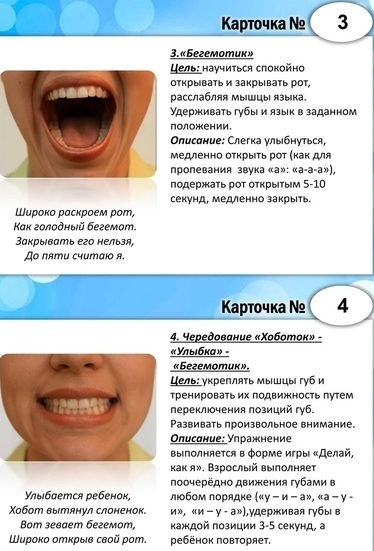
At the end, after these actions, an imitation of gargling is performed. All exercises are performed several times.
Lip gymnastics
To warm up the lips, first of all, close the teeth together and pull the lips into a tube, while trying to smile tensely.
Then they close their teeth and make various movements: up and down, left and right, circular movements. After that, lip chewing is performed.
Next exercise: pull your lips over your teeth and try to smile so that your lips slide over your teeth.
Then they move on to this exercise: tighten the upper lip, while exposing the upper teeth. Then they do the same only for the lower lip and jaw.
In conclusion, an imitation of "snorting" is performed.
Gymnastics of the tongue
Diction and articulation exercises also include language warm-up.
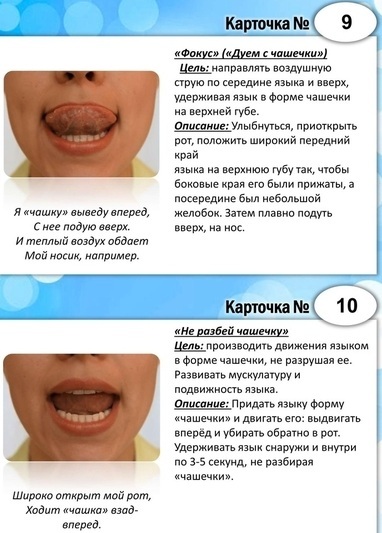
Techniques:
- The warm-up complex begins with a rotation of the tongue in the area behind the teeth. At the same time, during rotation, the tongue is held alternately near the left and right cheeks.
- Then the tongue is chewed.
- They lightly pat the tongue with their lips.
- Exercise "needle" - pulling the tongue in the form of a needle.
- They try to alternately reach the nose and chin with their tongue.
- Roll up the tongue with a tube and do pulls and pulls. During stretching, air is blown through the tube.
- They try to turn the tongue to different sides.
- At the end, they try to keep the tongue near the upper palate as long as possible.
After all the complex exercises, they move on to exercises that help improve the quality of diction before various performances.
Complexes and exercises for speech clarity
Exercises for clarity of speech are performed based on where the person will perform and his professional activities.
For public speaking
Before public speaking, in order for the speaker to be heard, it is necessary to carefully prepare.
Exercises:
- Pronunciation of tongue twisters. It is recommended to read such rhymes constantly, regardless of where the lecturer will speak. Over time, this will significantly improve the quality of the performances.
- Reading aloud. You can read a variety of literature - from classics to news stories. This will help to highlight accents in the text and improve intonation.
- Communication with people. It helps not only to learn how to express one's thoughts correctly and clearly, but also gives confidence to the speaker.
- Visualization of images. Anything can be imagined. However, it is necessary to visualize everything in the smallest detail.
-
Synonyms. Before speaking, it is recommended to do the following exercise: choose as many synonyms as possible for any words. This will increase your vocabulary and diversify your speech.
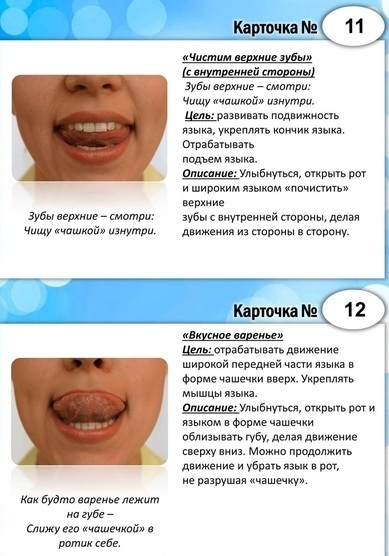

Also, before the lecture, it is necessary to warm up all sounds and the speech apparatus as a whole.
For vocals
Diction and articulation exercises for vocalists are carried out in 2 stages. The first is for good concentration of sound, the second is for the depth and beauty of the voice.
Exercises:
- It is necessary to sing the syllable "M" for a long time and evenly with a closed mouth. Lower the larynx, take a sharp breath through the nose. Then it is necessary to lower and relax the lower jaw, while the teeth remain open. The lips should be closed, the tongue is not tense. Begin the exercise with any convenient note, gradually increasing by semitone.
- Sing the syllable "Mi-i-i". The exercise is performed according to a similar (previous) scheme. When performing the technique, you should not strain the jaw and lips.
- "M-I-E-A-O-U-O-A-E-I". It is necessary to sing this combination naturally in one position. The sound should be concentrated at the tip of the front teeth.
- "RO-O-O-O-O-O". The mouth is wide open, the jaw is down, the lips are relaxed. It is necessary to sing academically between the sound "A" and "O". The larynx should be mobile - first it rises, then descends. Then you should depict a yawn with a sound that should rise from the chest.
At the end, you can do an exercise with the syllable "RO-O-O-O-O-O". It is performed according to the staccato principle, alternating rapid inhalation and exhalation.
For staging speech in children
Exercises for children must be performed daily, without missing a single day. The duration of the courses depends on what disorders the child has.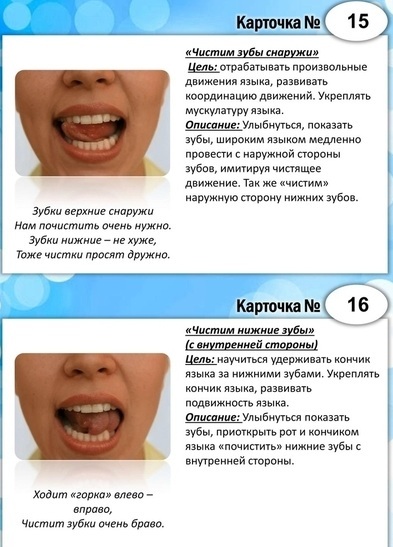
Techniques and techniques:
| Exercise title | Execution method |
| "Pipe". | The child should fold his lips in the form of a tube and push it forward as much as possible. |
| "Fence" | When performing this technique, it is necessary to smile so that the child's teeth are visible. It is recommended to perform the first and second warm-ups alternately. |
| "Rabbit" | The child should independently raise the upper lip as much as possible so that the incisor teeth are exposed. |
| "Angry horse" | Here it is necessary to imitate the snorting of a horse. In this case, the mouth should be closed. |
| "Piglet" | To begin with, the lips need to be folded in the form of a tube, after which it is necessary to begin to rotate them in different directions. |
| "Horse" | The exercise involves clicking the tongue, depicting the clatter of hooves. |
| "Fungus" | The child should firmly press his tongue to the palate and hold it in this position for as long as possible. |
| "Harmonic" | First, you should fold your tongue in the form of a fungus, and then open and close your mouth several times. |
| "Rybka" | It is necessary to draw in the cheeks and hold them in this position for a few seconds. |
| "Hamster" | First, the child should inflate both cheeks, and then do the same in turn. |
| "Shoulder" | The tongue must be placed on the lower lip. At the same time, the mouth must remain closed. |
| "Hours" | First, the mouth is opened, after which the tip of the tongue is alternately touching each corner of the mouth. |
Each exercise must be repeated several times. You need to hold each position for 5-7 seconds.
All techniques and exercises can be performed independently or you can contact a specialist who will help improve diction, restore articulation and deliver speech. Children are recommended to develop articulation under the supervision of a speech therapist.
All techniques and exercises can be performed independently or you can contact a specialist who will help improve diction, restore articulation and deliver speech. Children are recommended to develop articulation under the supervision of a speech therapist.
Diction Exercise Videos
Best diction exercise:

